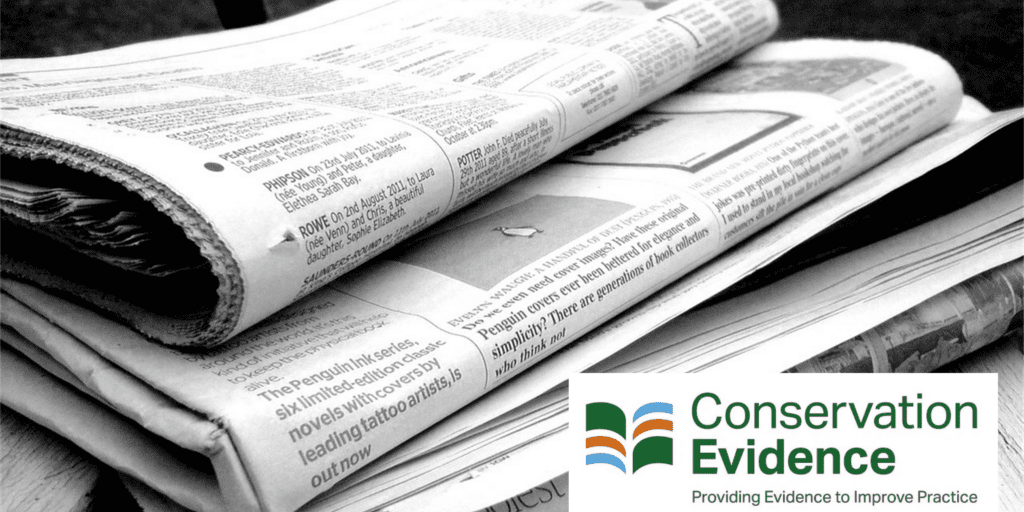The next steps for transforming conservation: ideas from the Effectiveness Revolution workshop
This blog post was written by Pamela Abbott (Natural Cambridgeshire), Holly Butterworth (Natural Resources Wales), Nicolas Heard (Mohamed bin Zayed Species Conservation Fund), Geoff Hilton (Wildfowl & Wetlands Trust), Becky Holmes (The Helvellyn Foundation), Julia Jones (Bangor University) and Jeremy Lindsell (A Rocha International).

The recent workshop Delivering the effectiveness revolution in conservation: lessons from organisations, policy makers and funders brought together 57 figures including funders, practitioners, policy makers and academics, with 220 people registered to attend online.
The aim was to discuss the ‘Evidence Emergency’ (The Wildlife Trusts’ term), the urgent need to embed evidence into decision-making and to create additional evidence to fill the considerable gaps in the evidence base, to improve conservation practice. During the workshop a series of speakers described how they had achieved cultural shifts to ensure that the work of their organisation was underpinned by evidence. All the talks are available to watch on the CCI YouTube Channel.
At the end of the workshop, we authors chaired six groups (three online) to consider how we build on the lessons of those who take evidence seriously to enable us to become an evidence-based community. Two groups focused on each of the following questions, with each thinking about what changes we practitioners (as funders, practitioners or policy makers) and others could make:
- How can funders facilitate mainstreaming the use and generation of evidence in conservation?
- What changes are needed for it to become unthinkable not to reflect on available evidence when designing a conservation project?
- What changes are needed for testing the effectiveness of conservation interventions to become routine?
Here we summarise some of the main conclusions, focussing on potential changes. Some of the main needs suggested were the following:
- Encourage Multilateral Environmental Agreements to embrace and drive evidence use. If the major agreements adopted an expectation of evidence use then this may drive use amongst governments and international organisations.
- Embed the culture of routine evidence use and testing. Creating a culture requires starting with effective recruitment, ensuring evidence use and competency at testing are integrated into job descriptions and interviews.
- Produce evidence for gains of using evidence. Research showing a 19% reduction in deaths from applying evidence-based medicine compared to standard practice provides a very powerful argument for evidence use in medicine. Research quantifying the increase in effectiveness in conservation could be equally powerful.
- Estimate the marginal cost benefit from using evidence. This helps to determine the level of resources that should be allocated to evidence gathering and use.
- Ensure meaningful peer-review and clear criteria to ensure project funding is contingent on evidence evaluation. Trained scientists can be involved at the commissioning and design stage of a project and as a project ‘customer’.

- Streamline how funders request evidence. The variety (and often complexity) of funding applications and processes can place a large time burden on applicants. There is a need to explore possible ways to streamline how funders request evidence, to ensure cohesion and simplicity for the applicants without creating substantial burdens on funders, or indeed applicants.
- Enthuse donor networks. Ask funding membership organisations to encourage their members to understand and request evidence-based conservation (e.g., through workshops or events).
- Create an evidence network that funders can become a member of, which champions the use of conservation evidence (e.g., “We are certified as evidence champion funders”) and enables the sharing of lessons.
- Reach out to conservation charity networks to encourage them to set and demonstrate high standards of evidence use amongst their member organisations.
- Include lack of evidence in feedback. Applicants often value feedback as to why an application is unsuccessful. If funders were to begin routinely sharing feedback if a charity failed to use evidence appropriately in their application, this would encourage them to do so in future applications. Similarly, practitioner/government organisations should be willing to discuss when evidence has not been used appropriately and to improve processes.

- Provide training workshops for grant applicants. Many conservation practitioners may not have the resources to increase their capacity for evidence use, and then implement the regular use of evidence to inform their work. More workshops on the use of evidence, like those run by People’s Trust for Endangered Species for applicants, could be useful.
- Regulatory bodies demand higher monitoring standards. Poor quality monitoring is common in much of industry, and when this happens very little is learnt about effectiveness of actions; regulatory bodies could set standards.
- Encourage more focused, hypothesis-based monitoring. Resources could be saved and lessons learned more readily, if monitoring was more focussed on answering specific questions, e.g. through an experimental test of an action, rather than on undertaking broad-scale monitoring (with no experimental design) that has limited use for answering priority questions.
- Centralise a solution to narrow the capacity gap in testing. Organisations often lack the capacity to experimentally test the effectiveness of actions. A centralised body (or ‘testing unit’), providing guidance and assistance to organisations, would greatly aid this.
- Create a standardised framework, or set of standards, for reporting results of experimental tests of actions. This would ease comparisons of studies.

- Incentivise multidisciplinary approaches that incorporate social sciences, economics, behaviour science and ecology in order to use the full width of necessary evidence.
- Develop ways to fund tests of actions beyond grant deadlines. Although experimental tests of many actions, such as means of controlling invasive plants, can be completed in months, other important questions may take considerably longer to answer. There is a need for processes that enable monitoring of outcomes outside the usual funding cycle.
- Big science in conservation. Explore whether large-scale data collection is practical, for example using remote sensing or passive acoustic monitoring to compare areas with specific management actions against those with no management, or between different ways of implementing the management action.
- Explore possibility of medical style ‘trial protocols’. These could enable standardised experimental design and evaluation in multiple locations allowing meta-analysis of the effectiveness of actions (some already done in marine field).
- Encourage sharing of results that show no effect or a negative effect. These results are also valuable. This can be achieved either by pre-registering tests or by testing small components of projects (rather than having to report that an entire project was ineffective).
It was accepted that currently there is a real problem with the lack of evidence use, and there was a general consensus and enthusiasm to ensure that evidence use was better embedded in decisions.
As part of this workshop discussion, a group of funders from varied funding backgrounds (e.g., Trusts and Foundations, Government, Individual Donors) collectively came up with ideas on how to facilitate mainstreaming of the use and generation of evidence in conservation. Crucially, it was agreed that more funders need to be made aware of the importance (or existence!) of evidence-based conservation. Funders have a relatively large amount of influence on conservation practitioners, so it is important to ensure that all funders impress on their grantees (or prospective grantees) the importance of using evidence. In this way funders can play an important role in the transformation to more effective conservation practice.
The workshop was co-hosted by the Cambridge Conservation Initiative (CCI), United States Fish and Wildlife Service (USFWS), TRAFFIC and Conservation Evidence.








